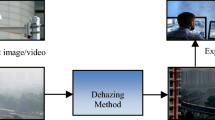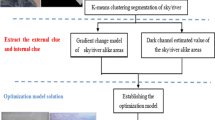Abstract
With the continual development of deep learning, the image processing in Internet of Things is the key technology. Nevertheless, many deep learning methods cannot deal with the special needs of Internet of Things, for example, the Internet of vehicles and ships for the traffic haze image. Particularly, haze removal in the water area, because of the influence of water vapor, is more difficult than that in the ordinary scene. And the dehazing of water area has practical value in shipping and aerial photography. Sensible dehazing effect can even ensure the safety of navigation. In this paper, a compensation textures dehazing method is presented for water alike scene. The motivation of this paper comes from the following observations. Dark channel haze removal method has a very real dehazing effect for ordinary scenes. However, due to the principle of the dark channel method, this dehazing method has a large deviation in the water alike area. Therefore, based on the classical dark channel method, this paper proposes three innovations. First, a dynamic priority method is designed. This method can calculate the priority order of patches according to the characteristics of the processed subject. Second, a compensation textures method is designed, which can compensate the special area according to the proposed priority method. Third, a new haze removal method is designed, which can effectively remove the haze of water area according to the proposed compensation textures method. The results of visual and quality experiment show that proposed method has a state-of-the-art dehazing result in the water alike area.







Similar content being viewed by others
References
Sattler T, Maddern W, Toft C et al (2018) Benchmarking 6dof outdoor visual localization in changing conditions. In: Proceedings of the IEEE Conference on Computer Vision and Pattern Recognition, pp 8601–8610
Lima A, Mendes D, Paiva S (2018) Outdoor navigation systems to promote urban mobility to aid visually impaired people. J Inf Syst Eng Manag 3(2):14
Weinstein A, Cho A, Loianno G et al (2018) Visual inertial odometry swarm: an autonomous swarm of vision-based quadrotors. IEEE Robot Autom Lett 3(3):1801–1807
Engin D, Genç A, Kemal Ekenel H (2018) Cycle-dehaze: enhanced cyclegan for single image dehazing. In: Proceedings of the IEEE Conference on Computer Vision and Pattern Recognition Workshops, pp 825–833
Xu K et al (2019) An improved SIFT algorithm based on adaptive fractional differential. J Ambient Intell Humaniz Comput 10(8):3297–3305
Majeed A, Rasool RU, Ahmad F et al (2019) Near-miss situation based visual analysis of SIEM rules for real time network security monitoring. J Ambient Intell Humaniz Comput 10(4):1509–1526
Niu Y, Lin W, Ke X et al (2017) Fitting-based optimisation for image visual salient object detection. IET Comput Vis 11(2):161–172
Yuzhen N, Wenqi L, Xiao K (2018) CF-based optimisation for saliency detection. IET Comput Vis 12(4):365–376
Liu W, Lau RWH, Wang X et al (2016) Exemplar-AMMs: recognizing crowd movements from pedestrian trajectories. IEEE Trans Multimed 18(12):2398–2406
Lee S, Yun S, Nam JH et al (2016) A review on dark channel prior based image dehazing algorithms. EURASIP J Image Video Process 2016(1):4
Borkar TS, Karam LJ (2019) DeepCorrect: correcting DNN models against image distortions. IEEE Trans Image Process 28(12):6022–6034
Yeung Y, Lu W, Xue Y et al (2019) Secure binary image steganography with distortion measurement based on prediction. IEEE Trans Circuits Syst Video Technol 30:1423–1434
Yang D, Sun J (2018) Proximal dehaze-net: a prior learning-based deep network for single image dehazing. In: Proceedings of the European Conference on Computer Vision (ECCV), pp 702–717
Li C, Zhao X, Zhang Z et al (2019) Generative adversarial dehaze mapping nets. Pattern Recogn Lett 119:238–244
Zhang J, He F, Chen Y (2019) A new haze removal approach for sky/water alike scenes based on external and internal clues. Multimed Tools Appl 79:1–23
Liu Y, Zhao G, Gong B et al (2018) Improved techniques for learning to dehaze and beyond: A collective study. arXiv:1807.00202
Xing H, Guo W, Liu G, Chen G (2016) FH-OAOS: a fast 4-step heuristic for obstacle-avoiding octilinear architecture router construction. ACM Trans Des Autom Electron Syst 21(3):30. https://doi.org/10.1145/2856033
McCartney EJ (1976) Optics of the atmosphere: scattering by molecules and particles. Wiley, New York, p 421
Tan RT (2008) Visibility in bad weather from a single image. In: IEEE Conference on Computer Vision and Pattern Recognition, 2008. CVPR 2008. IEEE, pp 1–8
Fattal R (2008) Single image dehazing. ACM Trans Graph (TOG) 27(3):72
Tarel JP, Hautiere N (2009) Fast visibility restoration from a single color or gray level image. In: Computer Vision, 2009 IEEE 12th International Conference on. IEEE, pp 2201–2208
He K, Sun J, Tang X (2011) Single image haze removal using dark channel prior. IEEE Trans Pattern Anal Mach Intell 33(12):2341–2353
Cai B, Xu X, Jia K et al (2016) Dehazenet: an end-to-end system for single image haze removal. IEEE Trans Image Process 25(11):5187–5198
Li B, Peng X, Wang Z, Xu J, Feng D (2017) Aod-net: All-in-one dehazing network. In: ICCV
Chen D et al (2019) Gated context aggregation network for image dehazing and deraining. In: 2019 IEEE winter conference on applications of computer vision (WACV). IEEE, pp 1375–1383
Ren W, Pan J, Zhang H, Cao X, Yang MH (2020) Single image dehazing via multi-scale convolutional neural networks with holistic edges. Int J Comput Vis 128(1):240–259
Wu M, Li X, Liu C et al (2019) Robust global motion estimation for video security based on improved k-means clustering. J Ambient Intell Humaniz Comput 10(2):439–448
Wang S, Gittens A, Mahoney MW (2019) Scalable kernel K-means clustering with Nyström approximation: relative-error bounds. J Mach Learn Res 20(1):431–479
Srinivasan A, Sadagopan S (2020) Rough fuzzy region based bounded support fuzzy C-means clustering for brain MR image segmentation. J Ambient Intell Humaniz Comput
Huang X, Yin C, Dadras S et al (2018) Adaptive rapid defect identification in ECPT based on K-means and automatic segmentation algorithm. J Ambient Intell Humaniz Comput 7:1–18
Criminisi A, Pérez P, Toyama K (2004) Region filling and object removal by exemplar-based image inpainting. IEEE Trans Image Process 13(9):1200–1212
Mittal A, Moorthy AK, Bovik AC (2012) No-reference image quality assessment in the spatial domain. IEEE Trans Image Process 21(12):4695–4708
Saad MA, Bovik AC (2012) Blind image quality assessment: a natural scene statistics approach in the DCT domain. IEEE Trans Image Process 99:1
Liu G, Guo W, Niu Y, Chen G, Huang X (2015) A PSO-based-timing-driven octilinear steiner tree algorithm for VLSI routing considering bend reduction. Soft Comput 19(5):1153–1169. https://doi.org/10.1007/s00500-014-1329-2
Liu G, Guo W, Li R, Niu Y, Chen G (2015) XGRouter: high-quality global router in X-architecture with particle swarm optimization. Front Comput Sci 9(4):576–594
Huang Xing, Guo W, Liu G, Chen G (2017) MLXR: multi-layer obstacle-avoiding X-architecture Steiner tree construction for VLSI routing. Sci China Inf Sci 60(1):1–3
Tu J, Xia Y (2015) Fast distributed multichannel speech enhancement using novel frequency domain estimators of magnitude-squared spectrum. Speech Commun 72:96–108
Cheng H, Chen G et al (2013) Links organization for channel assignment in multi-radio wireless mesh; networks. Multimed Tools Appl 65(2):239–258
Bin SQ, Xia YS (2014) Fast multi-channel image reconstruction using a novel two-dimensional algorithm. Multimed Tools Appl 71(3):2015–2028
Yang Y, Zheng X, Chang V et al (2017) Lattice assumption based fuzzy information retrieval scheme support multi-user for secure multimedia cloud. Multimed Tools Appl 77:9927–9941
Niu Y, Chen J, Guo W (2018) Meta-metric for saliency detection evaluation metrics based on application preference. Multimed Tools Appl 77:26351–26369
Chen C, Do MN, Wang J (2016) Robust image and video dehazing with visual artifact suppression via gradient residual minimization. In: European Conference on Computer Vision. Springer, Cham, pp 576–591
Ren W, Zhang J, Xu X et al (2018) Deep video dehazing with semantic segmentation. IEEE Trans Image Process 28(4):1895–1908
Narasimhan SG, Nayar SK (2002) Vision and the atmosphere. Int J Comput Vis 48(3):233–254
Nanda A, Sa PK, Chauhan DS et al (2017) A person re-identification framework by inlier-set group modeling for video surveillance. J Ambient Intell Humaniz Comput 10:13–25
Yu G H, Xu J, Cheng X (2018) Platform of quality evaluation system for multimedia video communication based NS2. J Ambient Intell Humaniz Comput
Nayreet I, Akramul A (2018) A multi-mode real-time system verification model using efficient event-driven dataset. J Ambient Intell Humaniz Comput
Liu G, Huang X, Guo W, Niu Y, Chen G (2015) Multilayer obstacle-avoiding X-architecture steiner minimal tree construction based on particle swarm optimization. IEEE Trans Cybern 45(5):989–1002. https://doi.org/10.1109/TCYB.2014.2342713
Wang S, Guo W (2017) Robust co-clustering via dual local learning and high-order matrix factorization. Knowl-Based Syst 138:176–187
Guo W, Liu G, Chen G, Peng S (2014) A hybrid multi- objective PSO algorithm with local search strategy for VLSI partitioning. Front Comput Sci 8(2):203–216. https://doi.org/10.1007/s11704-014-3008-y
Huang X, Liu G, Guo W, Niu Y, Chen G (2015) Obstacle-avoiding algorithm in X-architecture based on discrete particle swarm optimization for VLSI design. ACM Trans Des Autom Electron Syst 20(2):28. https://doi.org/10.1145/2742143
Luo F, Guo W, Yu Y et al (2017) A multi-label classification algorithm based on kernel extreme learning machine. Neurocomputing 260:313–320
Wang S, Guo W (2017) Sparse multi-graph embedding for multimodal feature representation. IEEE Trans Multimed 99:1
Chen F, Zeng X, Wang M (2015) Image denoising via local and nonlocal circulant similarity. J Vis Commun Image Represent 30:117–124
Niu Y, Lin L, Chen Y et al (2017) Machine learning-based framework for saliency detection in distorted images. Multimed Tools Appl 76(24):26329–26353
Acknowledgements
This work is supported by Science and Technology Department of Hubei Province, China (Grant No. 2014CFB383).
Author information
Authors and Affiliations
Corresponding author
Additional information
Publisher's Note
Springer Nature remains neutral with regard to jurisdictional claims in published maps and institutional affiliations.
Rights and permissions
About this article
Cite this article
Zhang, J., Feng, F. & Song, W. A compensation textures dehazing method for water alike area. J Supercomput 77, 3555–3570 (2021). https://doi.org/10.1007/s11227-020-03406-8
Published:
Issue Date:
DOI: https://doi.org/10.1007/s11227-020-03406-8




